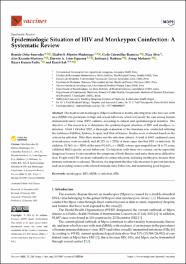Epidemiologic Situation of HIV and Monkeypox Coinfection: A Systematic Review

View/
Download
(application/pdf: 825.3Kb)
(application/pdf: 825.3Kb)
Date
2023-11-22Author(s)
Ortiz-Saavedra, Brando
Montes-Madariaga, Elizbet S.
Cabanillas-Ramirez, Cielo
Alva, Niza
Ricardo-Martínez, Alex
León-Figueroa, Darwin A.
Barboza, Joshuan J.
Mohanty, Aroop
Kumar Padhi, Bijaya
Sah, Ranjit
Metadata
Show full item recordAbstract
The most recent monkeypox (Mpox) outbreak is mostly affecting men who have sex with men (MSM) who participate in high-risk sexual behaviors, which is typically the case among human immunodeficiency virus (HIV) carriers, according to clinical and epidemiological statistics. The objective of this research is to determine the epidemiological situation of HIV and smallpox co-infection. Until 1 October 2022, a thorough evaluation of the literature was conducted utilizing the databases PubMed, Embase, Scopus, and Web of Science. Studies were evaluated based on the criteria for selection. Fifty-three studies met the selection criteria. A total of 6345 confirmed cases of monkeypox were recorded, and 40.32% (n = 2558) of these cases also had HIV co-infection. In addition, 51.36% (n = 3259) of the men (91.44%; n = 5802), whose ages ranged from 18 to 71 years, exhibited MSM-specific sexual behaviors. Co-infection with these two viruses can be especially dangerous because it can exacerbate the symptoms of both diseases and make them more difficult to treat. People with HIV are more vulnerable to certain infections, including monkeypox, because their immune systems are weakened. Therefore, it is important that they take measures to prevent infection, such as avoiding contact with infected animals, risky behaviors, and maintaining good hygiene.
Collections
- Web of Science (WOS) [236]

